Wonderkid to world-beater: George Best’s first five seasons in photographs
In less than half a decade, George Best went from wet-eared wunderkind to Golden Boot-wearing champion of Europe. Here are the photographs that tell the story
1. Making his mark
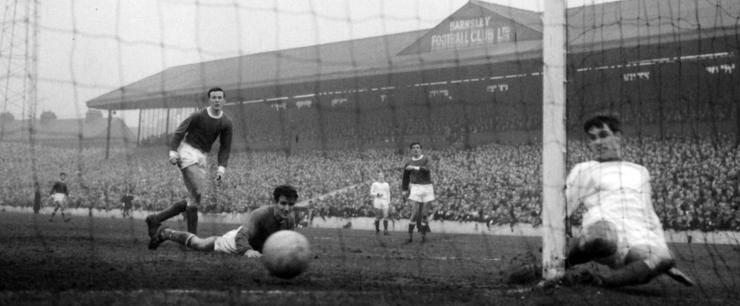
15 Feb 1964: George Best turns the ball in to score Manchester United’s fourth goal, completing an FA Cup Fifth Round rout of Barnsley at Oakwell. After making his first-team debut in the previous September’s home win over West Brom, Best had returned to the reserves and youth sides until a 6–1 Boxing Day beating at Burnley convinced manager Matt Busby to recall the 17-year-old — literally: he was back in Belfast having a family Christmas until summoned by telegram.
Best starred in United’s 5–1 win in the return game with Burnley (at the time, teams faced each other twice over Christmas) and became a first-team fixture, making 26 appearances and scoring six goals. United finished second in the league and reached the FA Cup semi-finals and European Cup Winners’ Cup quarter-finals; Best also helped United win the FA Youth Cup for the first time since the developing Busby Babes won it every year since 1953 and 1957.
2. Internationalist
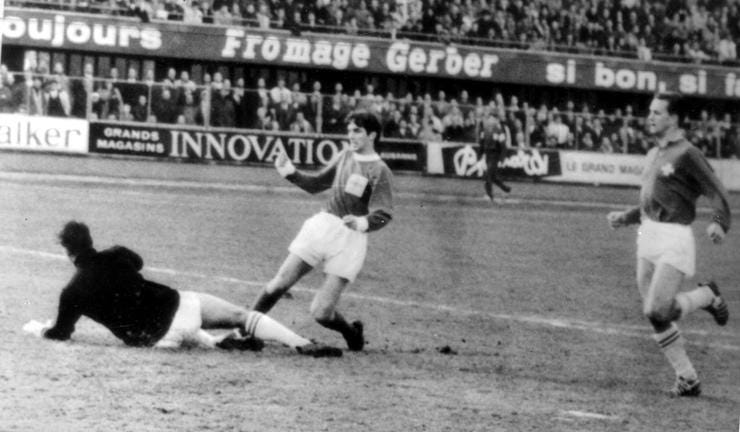
14 Nov 1964: Best scores his first goal for Northern Ireland, an equaliser in a World Cup qualifier in Switzerland. Best played in all six qualifiers for the 1966 World Cup, to be hosted in England, but Bertie Peacock’s team finished a point behind the Swiss. They had beaten the Swiss 1–0 at Windsor Park but couldn’t hold on to the parity Best had given them in Lausanne, losing 2–1.
Indeed, their away form would cost them qualification from the four-team group: they won all three at home but a disappointing draw in Albania — the hosts’ only point of the campaign — denied them the chance to finish level with Switzerland and force a play-off.
It was the closest Best got to a World Cup — Northern Ireland finished two points behind the Soviet Union in the race to Mexico ’70, while they were five points off Bulgaria’s pace for Germany ’74 and six points behind the Dutch for Argentina ‘78… although being in the Oranje’s group did give Best the chance to seek out and nutmeg Johan Cruyff.
3. Settling in well
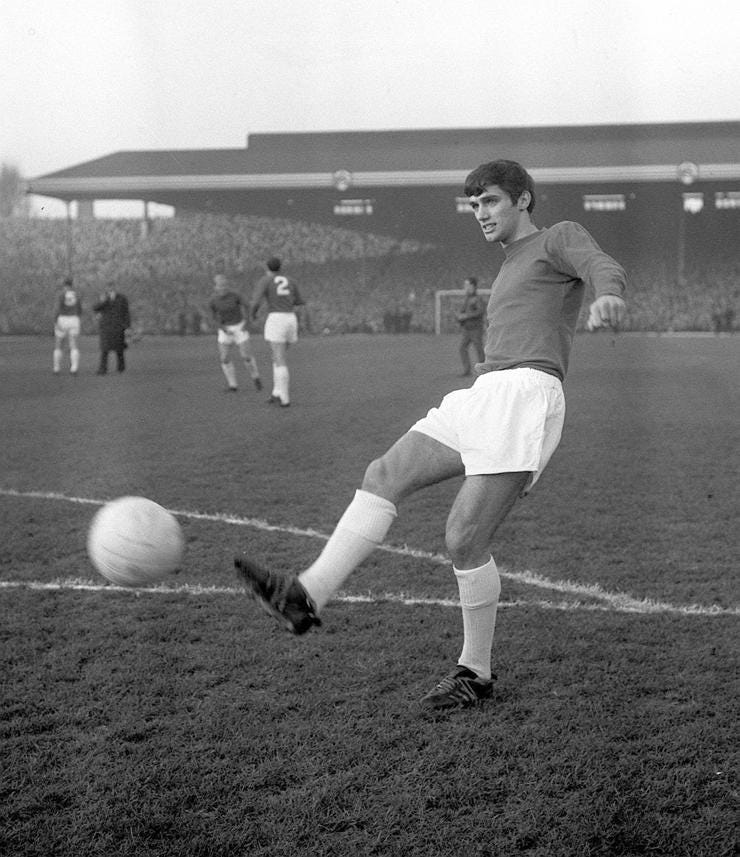
28 Nov 1964: Best warms up prior to kick-off at Highbury: note the North Bank in the background, with the Mayfield Laundry chimney in the background (it would close two years later, saving Sixties Gooners from being enveloped in clouds of steam before Saturday afternoon games).
By now, Best had been a regular for 11 months and was becoming accustomed to rough treatment from uncompromising opponents. It rarely fazed him — in fact, it often amused him. He was helped by Busby being perfectly happy for United’s sessions at The Cliff training ground to have an edge of menace: Best later described them as “fierce, almost brutal”.
It stood him in good stead. In 1964/65, his first full season, Best made 59 appearances in all senior competitions, scoring 14 goals. He would have more prolific seasons — including being the club’s top league scorer for five successive seasons to 1972 — but he would never again play as many games for United in a single campaign.
4. Meet the kids
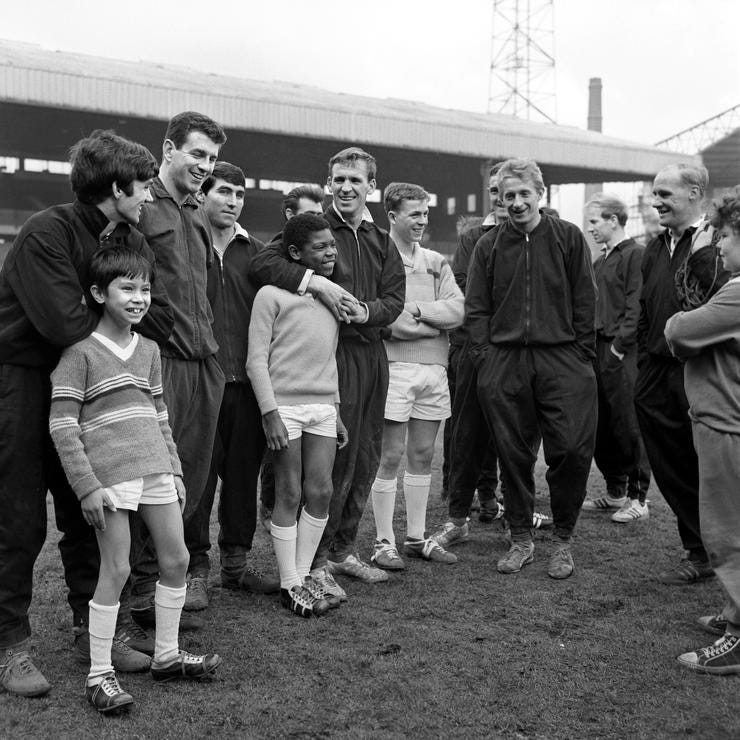
13 Apr 1965: United players meet schoolboys involved in shooting a film, with Paddy Crerand and Denis Law centre stage. Best is at the left, next to David Herd, United’s ‘other’ Scottish forward who would be their top scorer the following season.
Perhaps unjustly unrecognised outside Old Trafford, Herd scored 145 goals in 265 games for United — only a dozen men have scored more for the club — including a hat-trick past three different goalkeepers in a 5–0 hammering of Sunderland. Already in his thirties by the time this picture was taken, Herd broke his leg in March 1967; he battled back to fitness in time for the 1968 European Cup final, but Matt Busby instead opted to pick Brian Kidd on his 19th birthday.
The United players might have appreciated the diversion of the kids appearing at Old Trafford: they had just suffered an FA Cup semi-final replay defeat to their rivals Leeds United, freshly promoted to the top flight and seeking a first-ever league title under thrusting young manager Don Revie. Busby’s team would instead focus their efforts on a three-way title race with Leeds and Chelsea.
5. Things are looking good
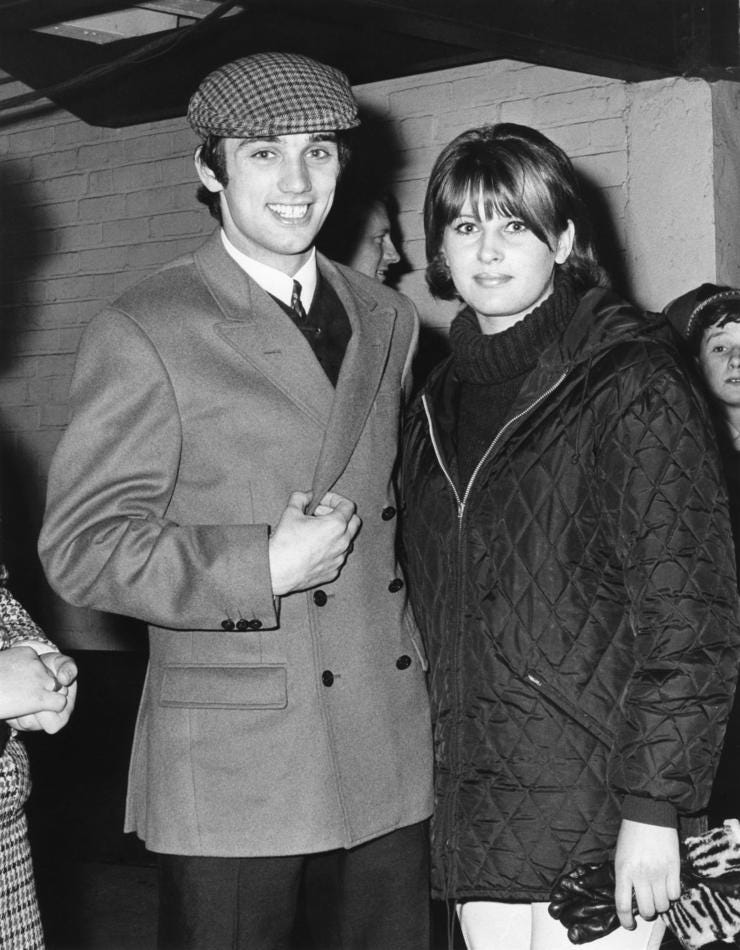
26 Apr 1965: Goalscorer Best with his girlfriend after beating Arsenal 3–1 at Old Trafford to all but secure Manchester United the league title.
Since losing the FA Cup semi-final to Leeds, Busby’s team had won six consecutive games to go clear of Don Revie’s Leeds and Tommy Docherty’s Chelsea; the vanquished opponents included Leeds themselves and outgoing champions Liverpool, who would console themselves with the FA Cup.
Under the goal average system, it had been calculated that they would have to lose 19–0 in their final game at Aston Villa to not win the title. In the end, they lost 2–1 and were champions of England for the first time since the Munich disaster. Best had played in all but one of the league games and contributed 10 goals.
6. European adventures
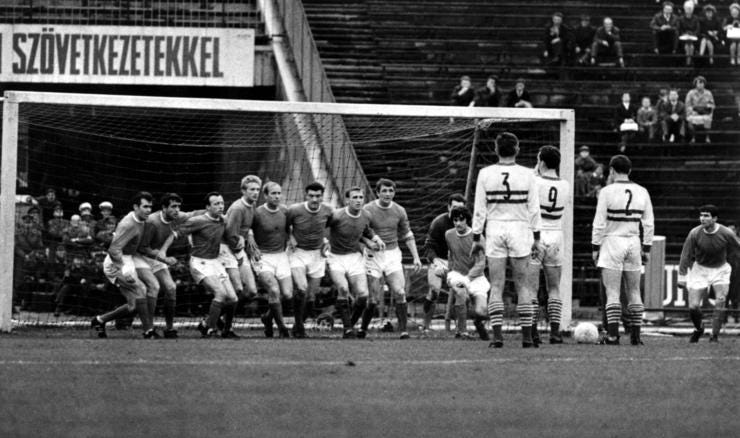
United players, l to r: John Connelly, Shay Brennan, Nobby Stiles, Denis Law, Bobby Charlton, Bill Foulkes, Pat Crerand, David Herd, George Best, goalkeeper Pat Dunne (hidden) and Tony Dunne.
6 Jun 1965: Ferencvaros’ Florian Albert and Dezso Novak face all 11 Manchester United players at a free-kick in the Inter-Cities Fairs Cup semi-final. The Fairs Cup, a forerunner of the UEFA Cup, was gaining in popularity even if it wasn’t yet under the auspices of Europe’s governing body, or indeed qualified for via league position. Matt Busby had long believed in European competition, and United would give it their best shot.
They tore past Djurgardens and Borussia Dortmund before edging out 1963 league winners Everton. When the competition restarted in May they demolished Strasbourg to face Hungarian side Ferencvaros in the semi-finals. A 3–2 win at Old Trafford was cancelled out by a 1–0 loss in Budapest; with nobody having yet invented the away goals rule, United got another go ten days later, but lost again in Hungary. European success would have to wait.
7. Bandy-legged and beaten
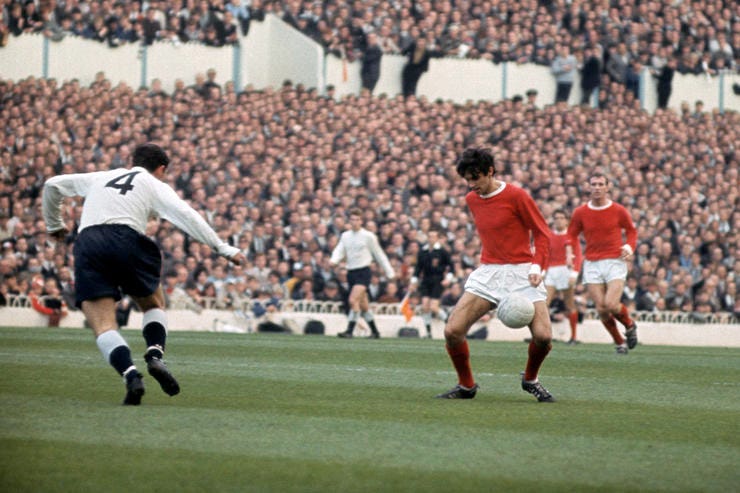
16 Oct 1965: An ungainly pose on an unfortunate afternoon for United, as the champions are crushed 5–1 at White Hart Lane.
Alan Mullery — the Tottenham right-half here seen closing Best down — noted that “Our play reached the highest peak in team-work”. Indeed, there was a goal for each member of Spurs’ five-man front-line (this was still an era dominated by 2–3–5, with Alf Ramsey’s alternative ideas yet to conquer the world), the pick of the bunch being Jimmy Greaves’ casual waltz through United’s defence.
It was a shocking result for the champions, but it was not in isolation: after scraping an opening-day win over Sheffield Wednesday, United had won just one in seven, suffering 4–2 defeats at Nottingham Forest and Arsenal and a 3–0 loss at Burnley. The White Hart Lane walloping left them in 13th place.
8. Style guru
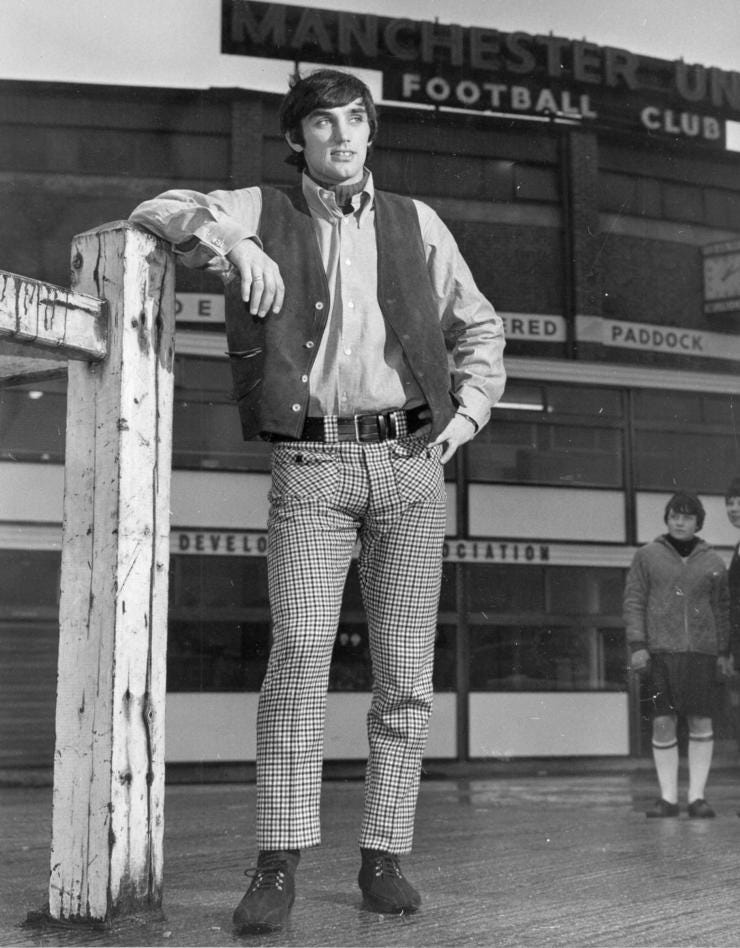
18 Dec 1965: Best stands outside Old Trafford. By now Best was becoming something of a style icon off the pitch, although it’s debatable how well the suede waistcoat and Rupert-check trousers — with double-width belt-loops and cross-pattern front pockets — have stood the test of time.
United had also got themselves into gear since the White Hart Lane walloping, winning seven of their next nine league games — climaxing with a satisfying 5–1 revenge beating of Spurs. Best scored six during that run as United rose to third in the table, but sadly for Busby something was stirring at the other end of the Manchester Ship Canal.
Bill Shankly’s Liverpool, having won the FA Cup in 1965, were determined to regain the league title they had won the season before; in one 18-game run they won 14 and lost just one, hitting top spot in November and never looking like giving it up. Busby’s thoughts turned instead toward the European Cup.
9. Bagging at Benfica
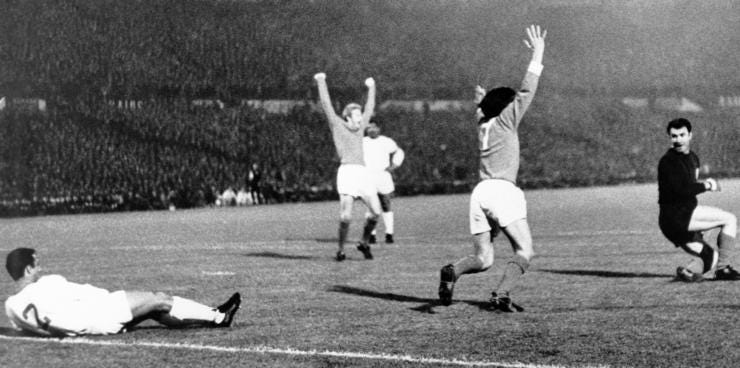
9 Mar 1966: Best celebrates opening the scoring at Benfica.
United’s first campaign in the European Cup since 1958 had started by easing past HJK Helsinki and Vorwarts Berlin, but things really got interesting with the quarter-final against Benfica, back under the aegis of the legendary Bela Guttman. United won an engagingly close game at Old Trafford 3–2, and Matt Busby informed his team to adopt a defensive strategy for the first 15 minutes.
Instead, in that time Best inspired them to a 3–0 lead. First he headed home a sixth-minute free-kick, then he doubled United’s lead, then John Connelly made it three on the night — and 6–2 overall. As Busby said to Best at half time, “Obviously you weren’t listening.”
Any hope Benfica held after Shay Brennan’s second-half own-goal was snuffed out by replies from Pat Crerand and Bobby Charlton. United had romped through to the semi-finals, 8–3 on aggregate against one of Europe’s best teams, and the belief was growing that they could mark the memory of Munich by winning the European Cup at the first attempt since 1958.
10. Shooting into stardom
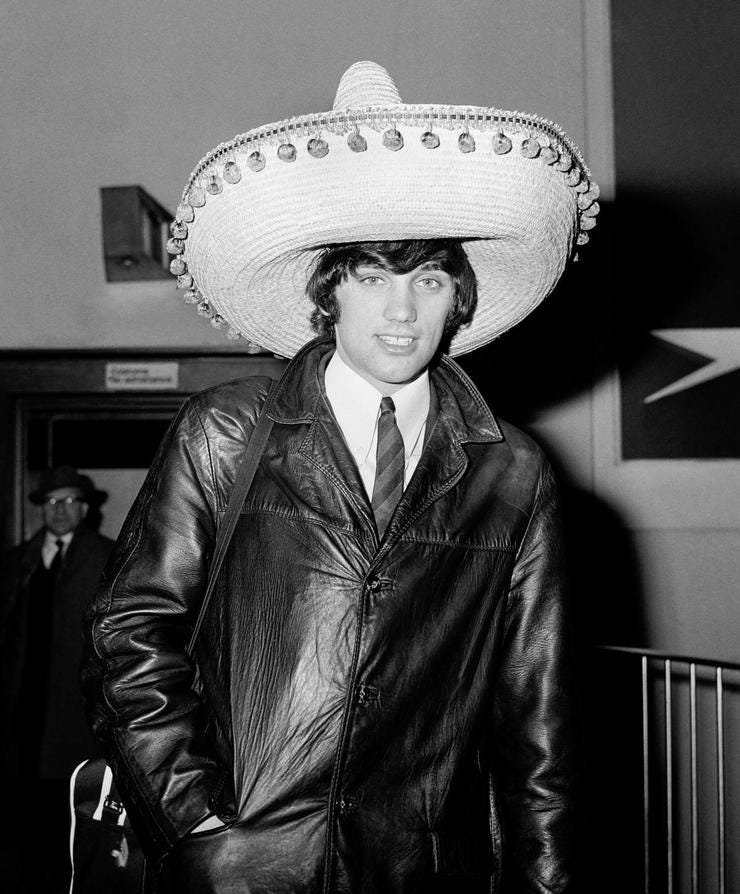
11 Mar 1966: Like many a tourist returning from Iberia to the British Isles in the 1960s, Best sports a sombrero as United land at Heathrow (freshly renamed from the rather more prosaic London Airport).
Best’s display at Benfica took him to another level of media interest across Europe; think of Gareth Bale’s explosive hat-trick at Inter Milan, multiplied by the sort of frenzy that occurred in days when football wasn’t available as 24-hour TV wallpaper. The Portuguese press, showing their own taste for an easy cultural reference, christened Best ‘El Beatle’, and he was certainly now becoming famous enough to be screamed at in the street.
United were the eighth British team in 11 years to reach the European Cup semi-final: Liverpool had been beaten by Inter the previous year, Dundee by Milan in 1963, Spurs by Benfica in 1962, Rangers by Eintracht Frankfurt in 1960, a post-Munich United by Milan in 1958, the Busby Babes to Real Madrid in 1957 and Hibs to Stade Reims in 1956. Sadly, they were to fall at the same hurdle.
The draw pitted them against Partizan Belgrade, meaning an emotional return to the last place the Busby Babes had played before the Munich disaster. A 2–0 defeat gave them too much to do in the home leg, with Nobby Stiles’ goal not enough to keep them in Europe.
11. Back to the day job
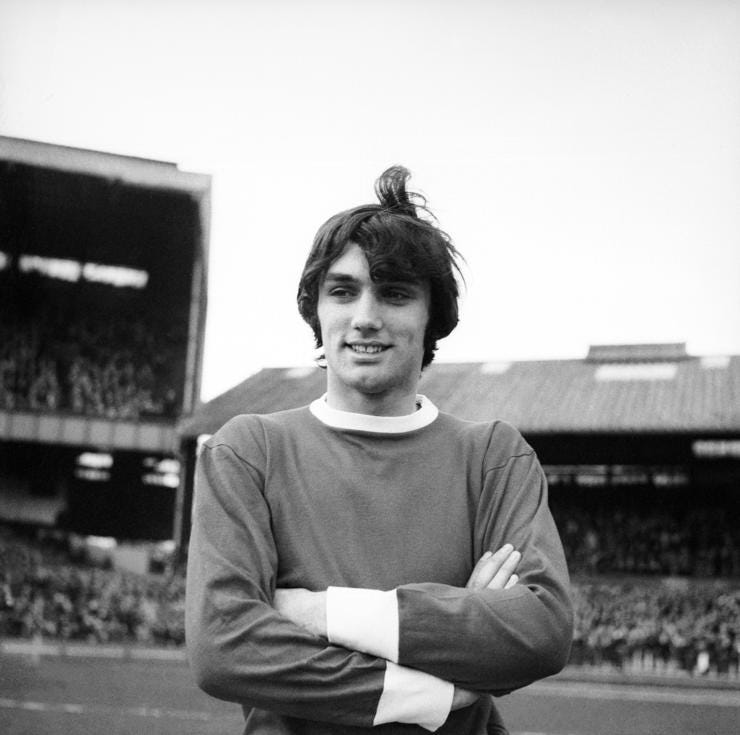
12 Apr 1966: Straight from Heathrow to a match the next day at Stamford Bridge. We assume George got a nice early night, but United lost 2–0, with Bobby Tambling scoring in the first minute and George Graham in the fifth.
It was only United’s second league defeat since that October bruising at White Hart Lane (the other loss being at leaders Liverpool), but it started a run of just two wins in nine league games as the champions’ thoughts turned towards Europe.
That run wasn’t helped by Best carrying an injury — caused, predictably, by a bad tackle. On 26 March he got his knee twisted in an FA Cup quarter-final at Preston, forcing him out of the next two games; although United’s staff insisted it was light enough for him to continue, he covertly consulted the Glentoran physio, who painfully readjusted his ligaments.
He played in heavy strapping for the loss at Partizan Belgrade on 13 April but missed the remaining 10 games; United won just four (including that insufficient home victory against Partizan), losing in the FA Cup semi-final to eventual winners Everton and finishing fourth in the league.
12. Hello again, old friend
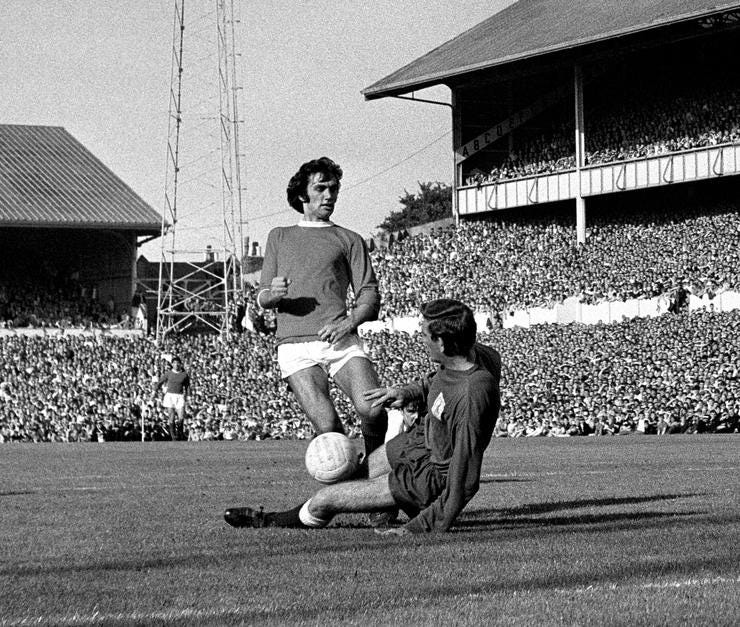
10 Sep 1966: Tottenham Hotspur goalkeeper Pat Jennings, wearing rather more Brylcreem than most will remember him for, dives feet-first into his international team-mate.
A year later, Jennings would score against United in the Charity Shield — amazing an audience watching the first match to be broadcast on colour TV in Britain.
Jennings went on to win 119 Northern Ireland caps, the last in 1986 on his 41st birthday against Brazil at the 1986 World Cup finals.
For his part, Best would only finally retire from professional football after a 1983 stint at Brisbane Lions in Australia, 20 years after his debut — and 11 years after he had first threatened retirement at Manchester United.
13. Digging into defence
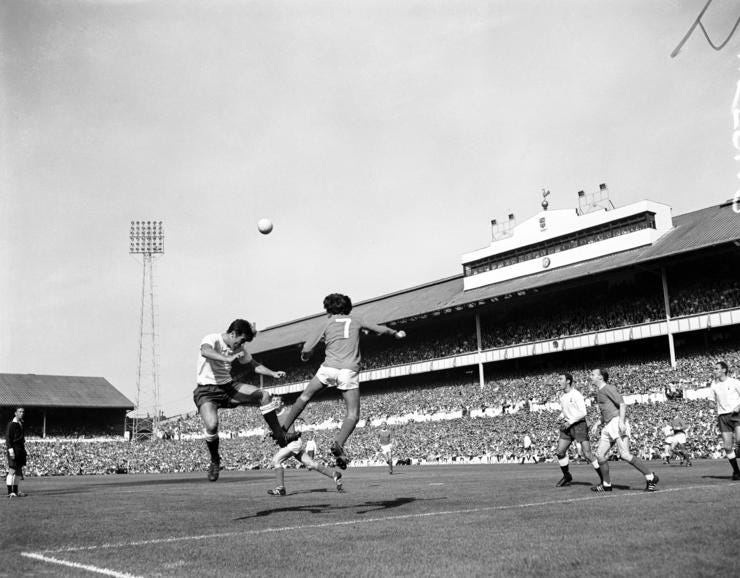
10 Sep 1966: Another shot from that game at White Hart Lane, but this time United are on the defensive — and Best is there again, heading away from the edge of his six-yard box.
As well as highlighting Best’s defensive dedication — not a trait often recalled — this picture gives a glorious view of White Hart Lane’s West Stand, plus familiar faces Terry Venables (going up with Best), Paddy Crerand (behind those two), and Jimmy Greaves being marked by Nobby Stiles.
Best set up the opening goal — a Denis Law header — but Spurs came roaring back late on to win through two goals in the last three minutes from Alan Gilzean and Jimmy Greaves.
14. Meanwhile, off the field…
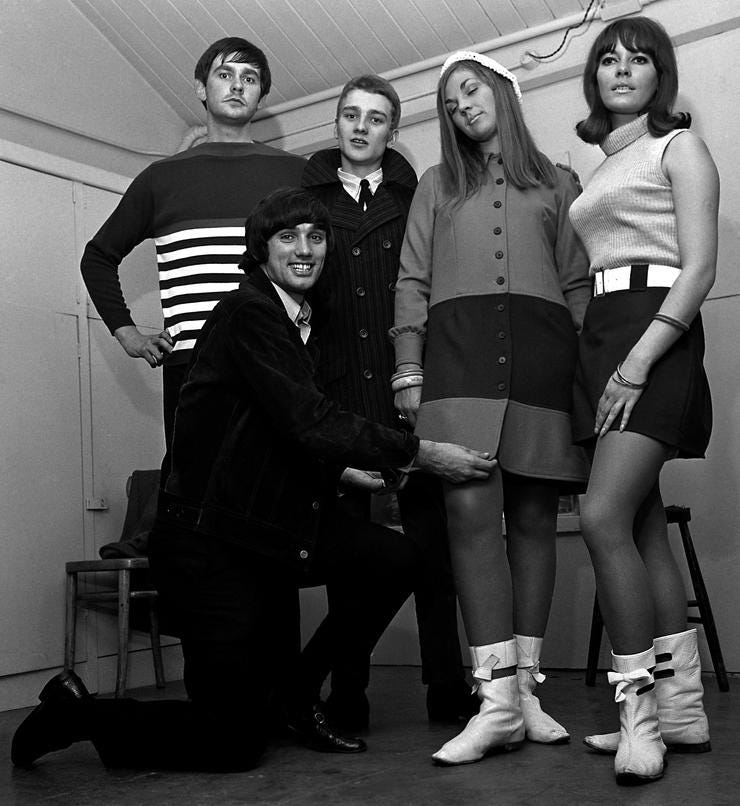
30 Sep 1966: Best — described in the contemporary picture caption as “Manchester United’s young Beatle-haired winger” — touches up the goods before a fashion show at Manchester nightclub Tiffany’s.
15. Up and running away
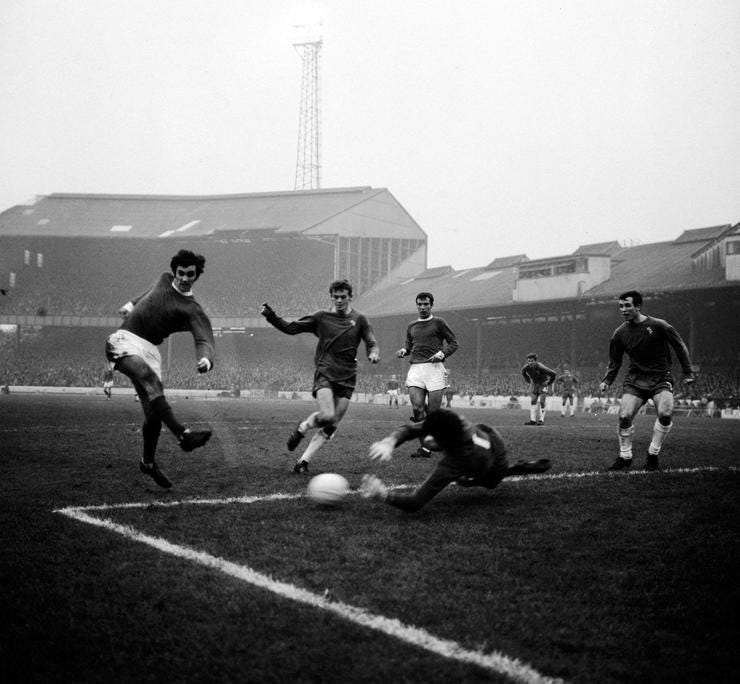
2 Nov 1966: Best’s shot is saved by Peter Bonnetti, watched by Chelsea’s Eddie McCreadie and John Hollins, along with Best’s old youth-team mucker David Sadler.
On the previous season’s trip to Stamford Bridge — note the old North and East Stands in the background — a post-Benfica defeat had heralded the end of United’s title challenge.
This season, it was quite the opposite. Best scored in a 3–1 win, and United’s early-season travel troubles — they had lost four of their first five away games — were in the past.
As Best put it, “If the championship was decided on home games we would win it every season. This time our away games made the difference. We got into the right frame of mind.”
16. Chicken run champions
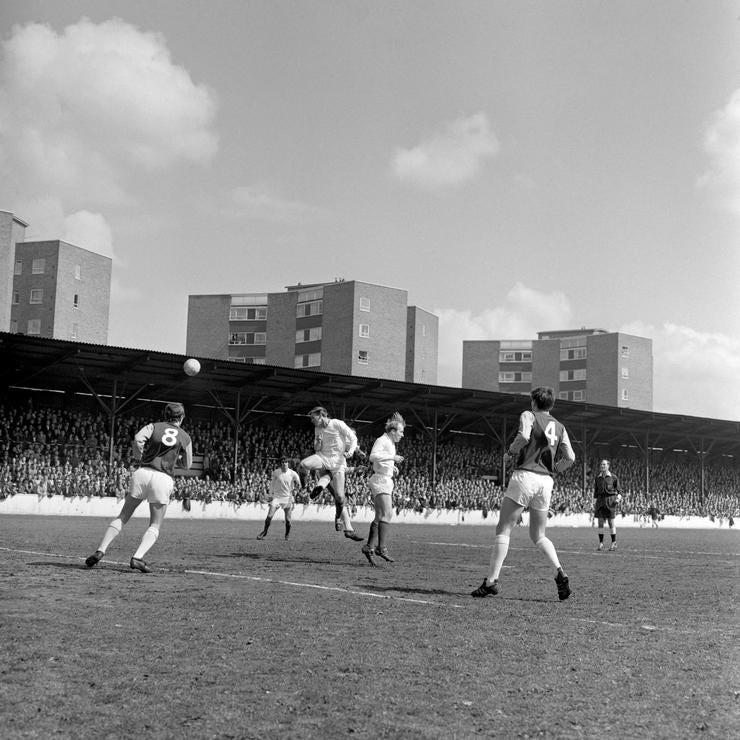
6 May 1967: Pat Crerand heads United’s second goal at West Ham, watched by Best (in the background) but not by Bobby Charlton (jumping back-to-back with Crerand), while Hammers Peter Bennett and John Bond look on. In the background is West Ham’s East Stand, aka the ‘Chicken Run’, two years before it was knocked down and rebuilt.
Table-topping United’s nearest challengers were Nottingham Forest, under Johnny Carey (who would have played far more than 350 games for United had he not been off fighting the Second World War for most of his twenties). After going unbeaten in 18 league matches since Christmas (including 10 wins), United had arrived in east London needing a draw to seal the title.
Instead of playing for a draw — against a side containing the three iconic World Cup winners Bobby Moore, Geoff Hurst and Martin Peters, not to mention a young Harry Redknapp — United tore into their hosts. Best, Crerand, Bobby Charlton and Bill Foulkes put the visitors 4–0 up by twenty past three. West Ham pulled a goal back through John Charles — not the Welshman who played for Leeds and Juventus, but the pioneering black full-back — only for a Denis Law double to make United champions with a flourish.
17. Bringing the trophy home
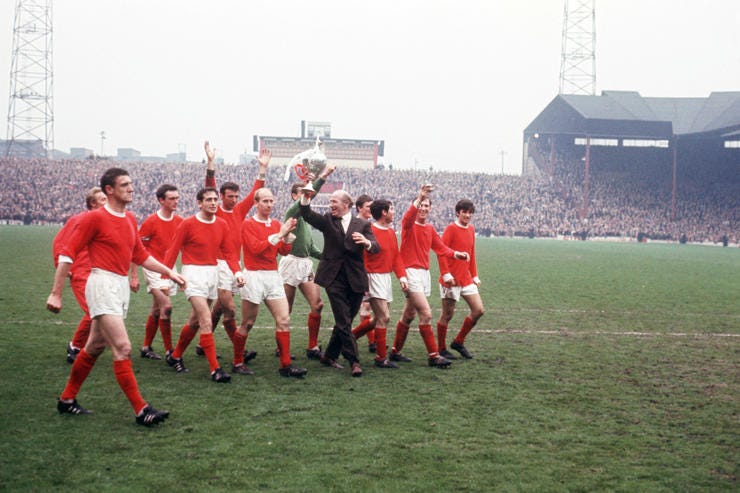
The champions (l-r): Denis Law, Bill Foulkes, John Aston, Shay Brennan, David Sadler, Bobby Charlton, Alex Stepney, Busby, Jimmy Ryan, Tony Dunne, Pat Crerand, George Best.
13 May 1967: Busby holds the League Championship trophy aloft as he and his players parade it around Old Trafford. In the background is the Scoreboard End, opposite the Stretford End and yet to be developed with the modern cantilever stand the club had already erected on the north side of the stadium; it would be extended round to the east in 1973, but the section of stand visible here survived until 1985.
18. Can we do this every year?
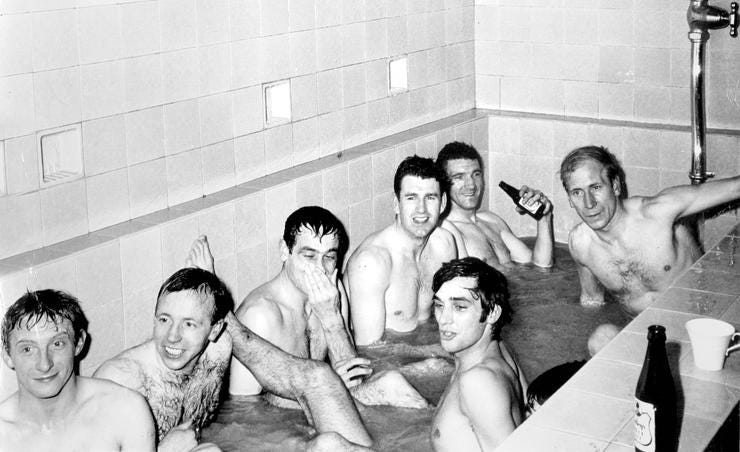
13 May 1967: United players Denis Law, Nobby Stiles, Shay Brennan, Jimmy Ryan, George Best, Bill Foulkes and Bobby Charlton celebrate winning the league with a bottle of beer in the plunge bath after the match.
It was the club’s second league triumph in three seasons, but it would become a millstone for a generation as United would not be champions again for 26 years.
An ever-present, Best contributed 10 goals to the cause. For the next five seasons he would be the club’s leading scorer in the league, but it says much for the strength of United’s team in 1966/67 that he was outranked by Charlton (12 league goals), David Herd (16) and Law (23).
But with Herd having broken his leg, Best was now to be more heavily relied upon for goals.
19. A very good year
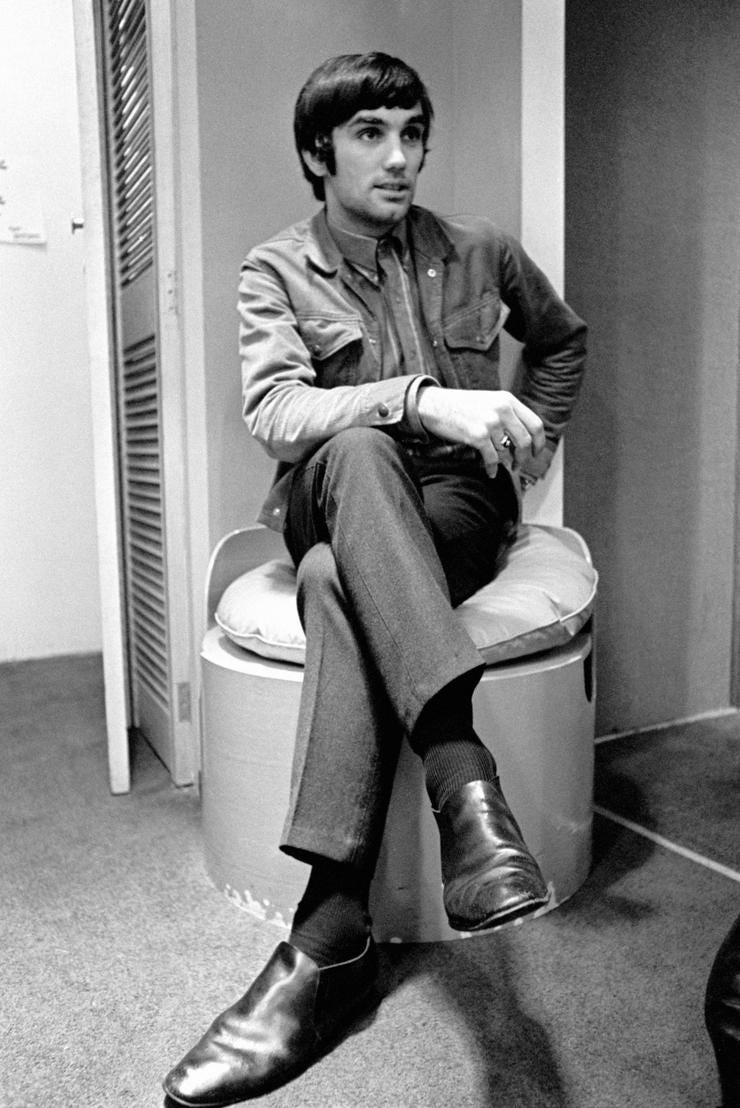
1 Jun 1967: Well-dressed Best relaxes in his boutique, on the day The Beatles released Sgt Pepper to kick off the “Summer of Love”.
We won’t go into George’s adventures in that close season.
20. Best on wheels
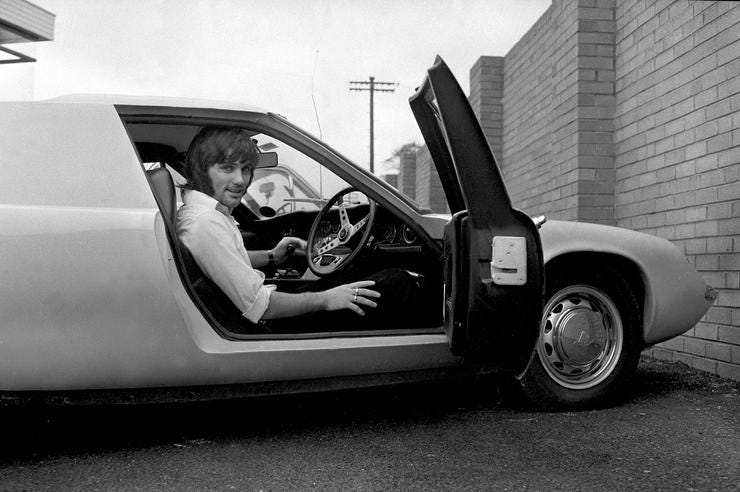
1 July 1967: Best in his motor, parked worryingly close to a wall.
21. Quietening the neighbours
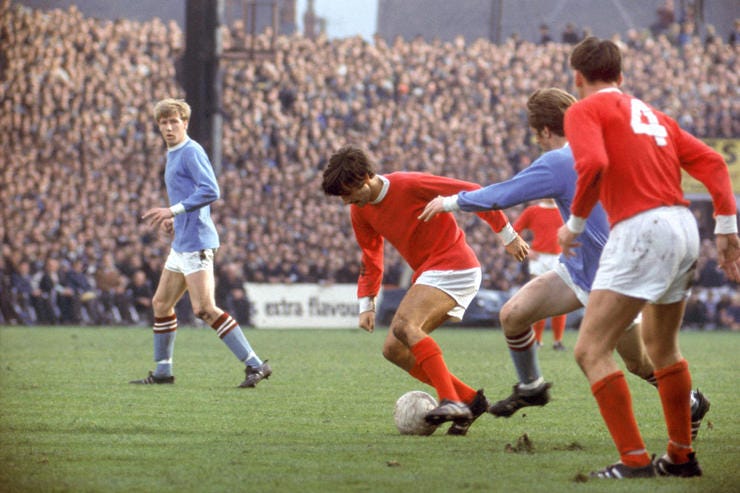
30 Sep 1967: Best in action at Manchester City. After three seasons outside the top flight, the Maine Road men were back on the scene and hunting their first league title since 1937.
The managerial double-act of avuncular Joe Mercer and innovative coach Malcolm Allison had clinched the Second Division title in 1965; although City had finished in lower mid-table in their first season back — this in an era when Ipswich had won the league in their first season back (1962), Leeds had almost done likewise (1965) and Liverpool had done it at the second attempt (1964) — they had found their feet by the end of 1966/67 and only lost four of the last 17 games.
Fired up by local rivalry — Paddy Crerand had bet Allison £10 that after United’s title win City would never again get crowds of 30,000 — City started the season confidently and were above United when the neighbours popped round in September.
Colin Bell opened the scoring after five minutes, but two Bobby Charlton goals kept the home fans quiet, bar a brief rally when Stan Bowles and Brian Kidd had a punch-up.
22. Bestie ’n’ Buzzer
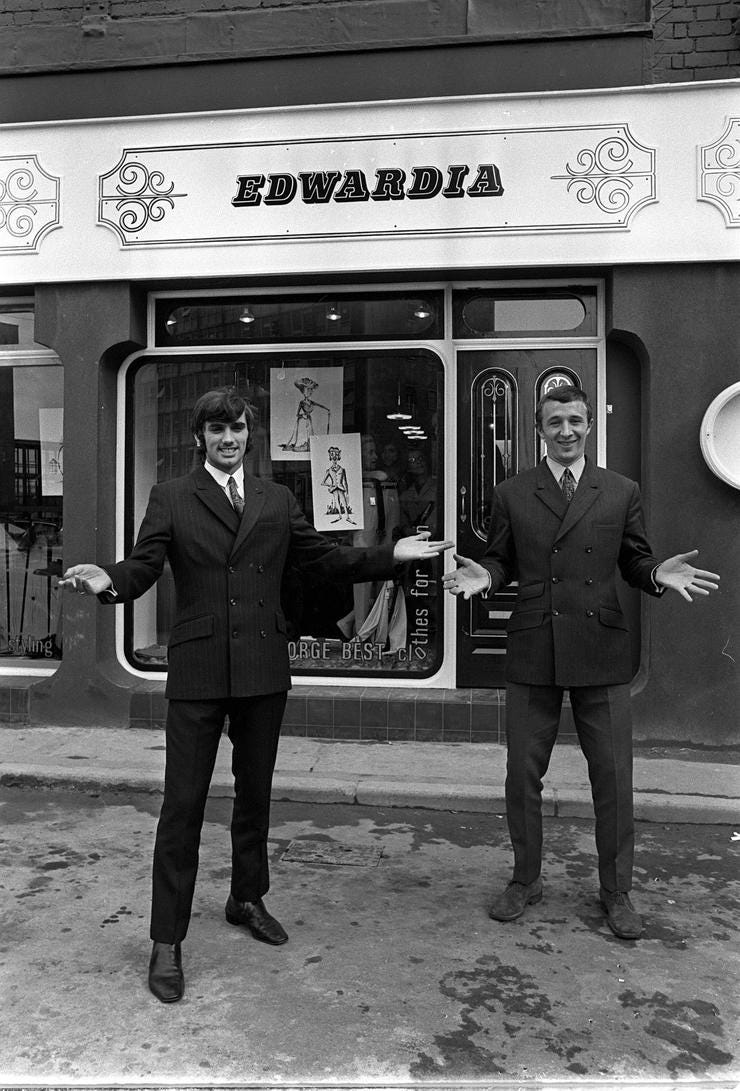
10 Oct 1967: Best and Manchester City’s Mike Summerbee outside their Manchester boutique Edwardia.
Although their teams were rivals on the pitch, Best and Summerbee got on well off the pitch.
The City right-winger, known as Buzzer to his team-mates, was a practical joker always looking for fun — and developed a firm friendship with Best, equally happy to find entertainment to fill the hours.
23. White hot Lane
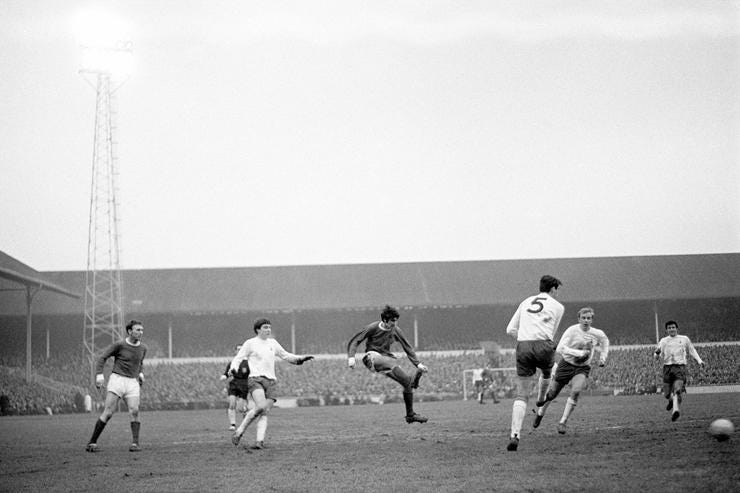
3 Feb 1968: Best shoots for goal at Tottenham. You can’t blame him — he was in sparkling scoring form, and his goal in the 2–1 win at White Hart Lane was his sixth in five games.
After a 26-game run featuring 17 wins and just two losses, United were top by three points from Leeds, with Man City back in fourth behind Liverpool and six points — three wins — off the pace.
However, United’s form suffered as the European Cup came back into view.
Matt Busby’s side had beaten Hibernians of Malta and FK Sarajevo in the autumn, but the end of February brought a potentially tricky quarter-final with Polish side Gornik Zabrze, and after White Hart Lane United would lose three of their next four league games, while four straight wins for free-scoring City — by now had completed their own Holy Trinity by adding Bolton forward Franny Lee to Mike Summerbee and Colin Bell — took Joe Mercer’s side top on goal average.
24. Title fighters
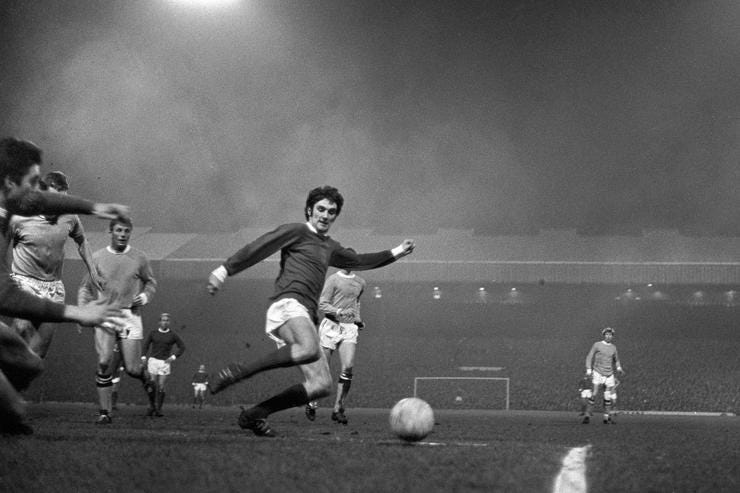
27 Mar 1968: Best takes on Manchester City at Old Trafford. In mid-March United saw off Gornik Zabrze by protecting their 2–0 lead from the home first leg with a nervy 1–0 loss in Poland. Through to the European Cup semi-finals, they had six weeks to square off against their title rivals.
As soon as they hit top spot, Man City lost at Leeds, who replaced them atop the league; with United and Liverpool also winning, that left four teams within two points of each other ahead of a crucial midweek Manchester derby at Old Trafford.
United took the lead when Best seized on a sloppy back pass by City skipper Tony Book, but Colin Bell equalised. Shortly after half time, centre-back George Heslop nodded City in front and with United chasing the game, Bell broke clear, was brought down and Franny Lee’s spot-kick completed a 3–1 win.
City then lost at Leicester, but United also lost at home to Liverpool — Best again scoring United’s only goal — as Busby’s men got what they least wanted during a European Cup campaign: a four-way title fight with their three most passionate rivals, Leeds, Liverpool and Manchester City.
25. Futuristic at Fulham
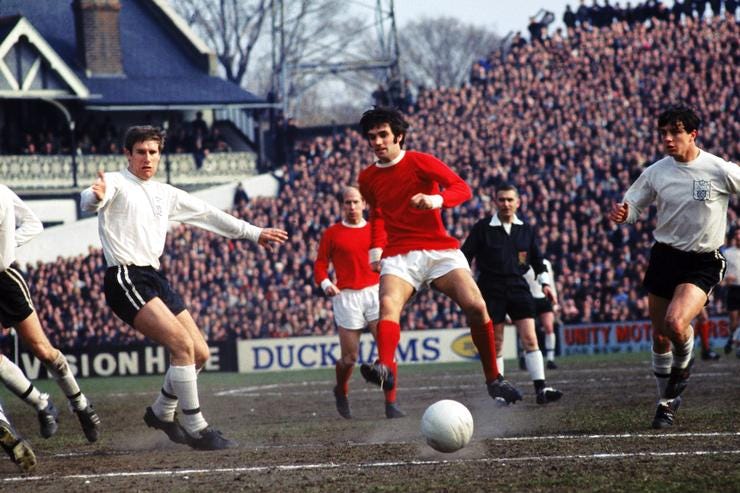
Apr 12, 1968: United at Craven Cottage. It has been noted that fashions often lag behind the decades they’re associated with, partly because it takes a while for mass-market penetration of new styles. But somehow Best looks to be from a different era to everyone else in this image — whether it’s Fulham in their Fifties kit (and Edwardian pavilion) or respectably balding team-mate Bobby Charlton.
Easter meant a double-header on Good Friday and Easter Saturday, on this occasion to be followed by another fixture before the following Saturday’s game. Going into this sprint of four league games in nine days, the Uniteds of Leeds and Manchester were two points clear of Liverpool and Manchester City; Liverpool took four points from the eight available, City five, Leeds six and the Red Devils seven, starting by dismissing Fulham 4–0.
Best scored four goals in the four games, after which Busby’s men were a point clear of Leeds and four clear of City, having played a game more than either. They had done what they could, and turned their attention to a midweek European Cup semi-final against Real Madrid.
26. The Real thing
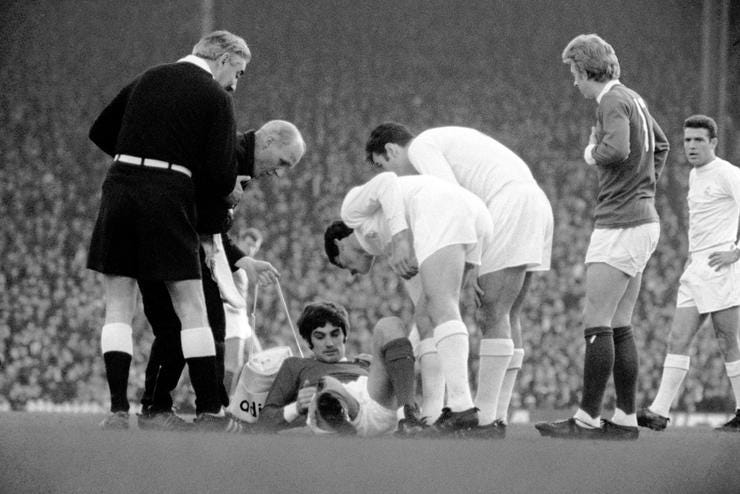
24 Apr 1968: The first leg of the European Cup semi-final against Real Madrid. Referee Tofik Bakhramov — formerly known as the actually-not-Russian linesman from the 1966 World Cup final — prevents Manchester United trainer Jack Crompton treating Best, while Denis Law watches a couple of Madrid players getting involved.
Having won the first five European Cups, Madrid had won it again in 1966 and were arguably the best team in Europe, alongside Internazionale, who had been champions of Europe in 1964 and 1965 and lost to Celtic in the 1967 final. Matt Busby couldn’t wait for it, forecasting that “If the tension does not become too great, this could be a classic match. The old Real Madrid had a touch of magic about them. Now, after rebuilding, they are moving back towards greatness.”
27. A slender lead
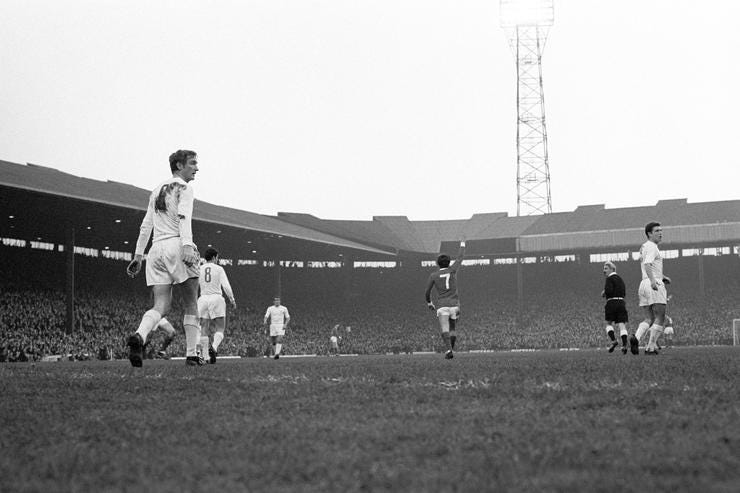
24 Apr 1968: Best celebrates the only goal against Real Madrid. After all the build-up, the first leg didn’t quite up to expectations. Part of that was down to Madrid being unusually defensive, fielding what some described as a back five. Paddy Crerand hit the post but Best opened the scoring, pouncing on John Aston’s low cross a few minutes before half-time. However, United couldn’t extend their lead and the score remained 1–0.
After the game, most pundits felt that a single-goal led wouldn’t suffice in the Bernabeu, and that United were doomed to become the ninth British team in 13 years to lose a European Cup semi-final. Busby, taking succour from Celtic’s trophy triumph the previous year, believed it was his side’s destiny to win the final at Wembley.
That determination was only intensified during the three-week wait for the second leg as United lost their league title to their nearest neighbours. A 6–3 loss at West Brom on Easter Monday handed the initiative to the Maine Road men, who won their final three fixtures to capture their first top-flight title for 31 years (and their last until 2012). Busby, typically, found a way to accentuate the positive.
“The slip in the league could be the spur and the players were all of that opinion both when we trained and when we discussed this European Cup match”, confessed the manager. “This cup Manchester United wants to win most of all. It is and has been uppermost in our minds. It is something we want to bring back to England.”
28. Bernabeu brilliance
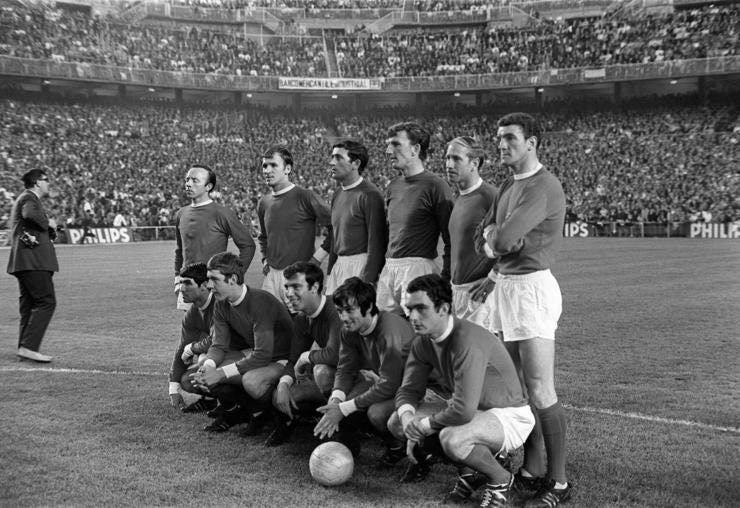
United in the Bernabeu. Left to right, back row: Nobby Stiles, Pat Crerand, Shay Brennan, Alex Stepney, Bobby Charlton and Bill Foulkes. Front row: Tony Dunne, Brian Kidd, David Sadler, George Best and John Aston.
15 May 1968: United defended as doggedly as Madrid had in Manchester, stacking two banks of four in front of Alex Stepney’s goal, but were undone by a 32nd-minute set-piece, Amancio chipping in for Pirri to head home. Within 10 minutes Madrid scored again when veteran winger Francisco Gento hammered into the corner, and although Ignacio Zoco sliced into his own net, Real regained the aggregate lead through Amancio.
After the break United stuck to their task, and in the 73rd minute Best nodded on a free-kick and David Sadler scored with his knee. Five minutes later, Best was again the provider for the equaliser on the night and what turned out to be the goal that took United to their first European Cup final.
With a touch to make a romcom screenwriter blush, the crucial goal was scored by Bill Foulkes, the 36-year-old veteran not just of three losing semi-finals for United but also the Munich disaster. Steaming forward onto a perfect cross from Best, the centre-back side-footed home with a calmness you might not expect of a man who only scored nine goals in his 18-year United career; indeed, Best was only half-joking when he said that had he realised it was Foulkes, he wouldn’t have passed to him…
29. Footballer of the Year
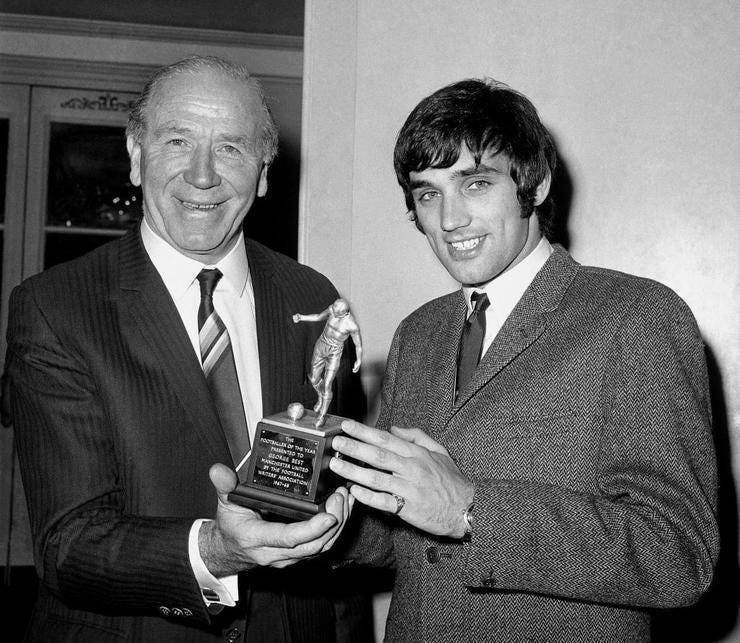
16 May 1968: A week shy of his 22nd birthday, Best becomes the youngest ever Footballer of the Year. He polled 60% of the Football Writers’ Association votes, becoming the third United winner in the trophy’s 20-year existence after Johnny Carey (1948) and Bobby Charlton (1966).
Although the PFA award didn’t start until 1974, Best also received other personal accolades for his season’s work.Already the First Division’s joint top scorer (having scored 28, the same as Southampton’s Ron Davies), Best would go on to be named the European Footballer of the Year — United’s third in five seasons after Charlton (1966) and Denis Law (1964). The Holy Trinity was in place.
30. Facing down Benfica
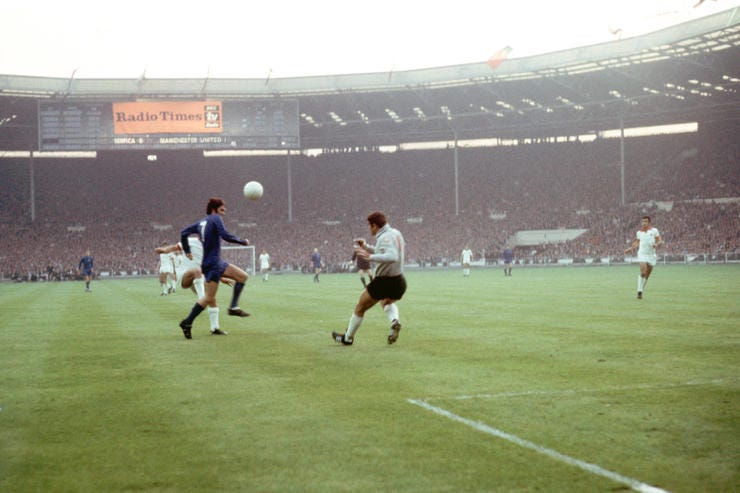
29 May 1968: Best bears down on Benfica goalkeeper Jose Henrique in the European Cup final at Wembley. United had the benefit of a “home” fixture but the humid evening was better suited to their Iberian opponents, including 43-goal European Golden Shoe holder Eusebio, while Denis Law was still out injured. Both teams changed from their usual red, Benfica to white and United to dark blue.
In truth, the match didn’t start too enticingly. Benfica well remembered Best’s “el Beatle” masterclass two years earlier and marked him tightly, while Nobby Stiles was rarely more than touching distance from Eusebio — and neither side was above administering the odd crunching tackle to their illustrious opponents, even if Stiles couldn’t stop Eusebio crashing a shot against the bar.
United took the lead early in the second half when Bobby Charlton nodded in a David Sadler cross, but with 11 minutes remaining Jaime Graça equalised. Benfica, in their fifth European Cup final in eight years, had their own demons to exorcise having lost two finals in the previous five years, pressed for the winner and almost got it when Eusebio raced clear — but Alex Stepney, figuring his foe would want to blast the ball, stayed on his feet and felt Eusebio’s shot cannon off his chest and out to safety. Extra-time — and history — beckoned.
31. Into history
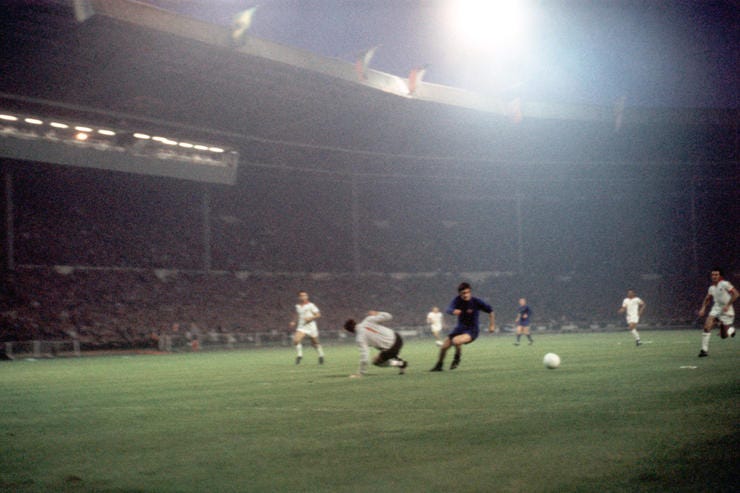
29 May 1968: Best goes past Jose Henrique to put United in front. The Mancunians had slumped to the turf at the end of normal time, but they tore into Benfica at the restart and within two minutes Best had turned the game decisively. Finally losing his markers, he latched onto a Brian Kidd header, skipped past one tackle, rounded Henrique and calmly tapped the ball home. A minute later Kidd doubled the difference, and shortly afterwards Charlton made sure with his second, United’s third headed goal of the evening making it 4–1.
At the final whistle, as United players and staff embraced on the pitch, Benfica’s Brazilian coach Otto Gloria betrayed a certain bitterness while also acknowledging the victors’ virtues: ‘Manchester United are very good and they had a big advantage at Wembley. Some of the Benfica players like Torres and Coluna felt some difficulty early on with knocks and could not produce the football they normally would. The title is in very good hands.’
In truth, it didn’t matter what others thought. Matt Busby — knighted later that year — had finally become a European champion. Typically, he shunned the limelight, refusing a request by his senior players to go up for the cup himself.
32. Champion of youth
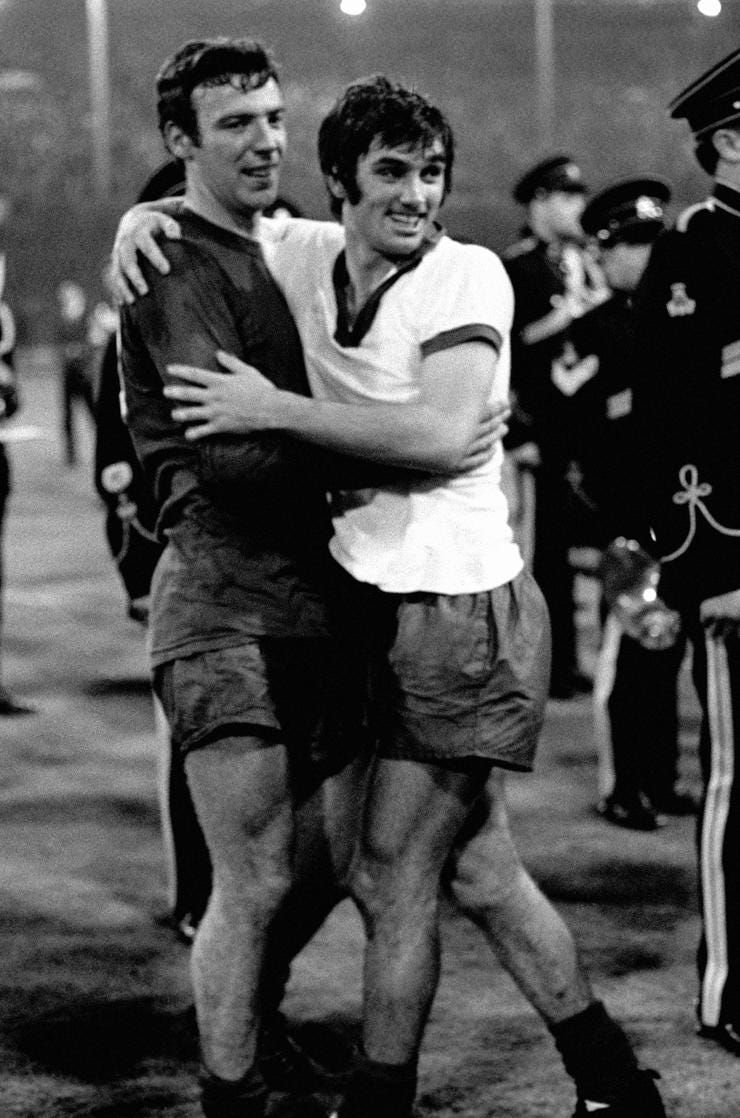
29 May 1968: Best and David Sadler celebrate winning the European Cup. Five years earlier, Best had been “green with envy” when his fellow youth-team prospect had made his first-team debut ahead of the Northern Irishman; now they were united in victory at the age of 22.
Kent-born six-footer Sadler had joined United from Maidstone, with whom he had been an England Amateur international. Like Best, he would stay at United until the 1973/74 season — but he left to join Preston, then managed by Bobby Charlton, whereas the Belfast genius had other reasons to leave. But that’s another story…
Originally published by FourFourTwo on November 25, 2015.





